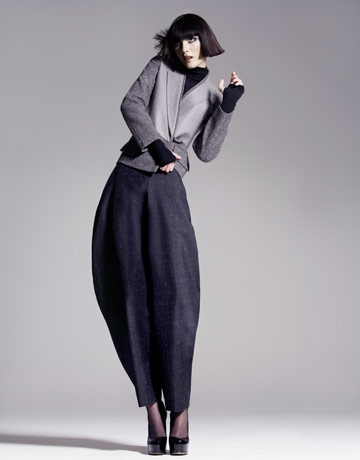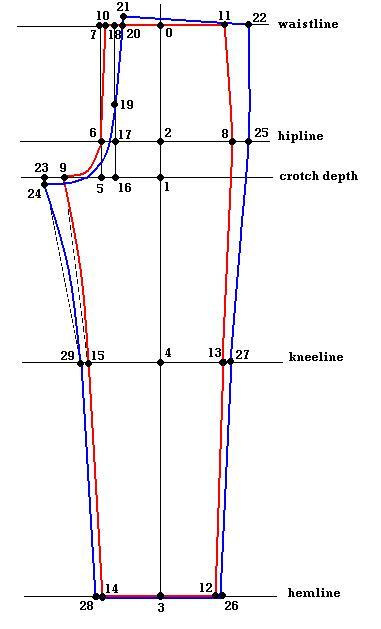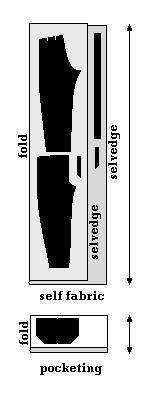 Featured: Stefano Pilati for YVES SAINT LAURENT
Featured: Stefano Pilati for YVES SAINT LAURENT
Explore volume and proportion by challenging conventional principles of tailoring for your Autumn wardrobe. Here is a great example by Stefano Pilati for YVES SAINT LAURENT, a ‘zoot’ trouser balancing a fitted cropped top. The pattern draft is a bit more advanced for those daring to try pleated trousers yet it is an easy project to construct.
You will need:
- Bottom-weight fashion fabric, 54” [137cm] wide **
- ¼ yd. [0.25 m] of fusible interfacing, 45” [114cm] wide.
- ⅓ yd. [0.30 m] of pocketing fabric, 45” [114 cm] wide
- 1 zipper, 7” [18 cm] long.
- 1 set of pant hook & bar
- Kraft paper
** A minimum of 3 yards of fabric is required for pleated trousers – for an average sized person. If you’re taller than 6′ – you’ll need 3 1/2 yards of fabric.
MEASUREMENTS
Waist – measure around narrowest part of torso just above the navel.
Hip – measure around fullest part of seat, about 9” [23cm] below waistline.
Body Rise – measure vertically from waistline to top of chair seat, while seated.
Outseam – measure vertically from waist to heels.
Trouser Bottom Width – measure length of foot.
PATTERN
Easy Fit template for “baggy” trousers.

Front (Red)
Draw a long straight line down center of the paper and plot point 0 at the top end.
Square both ways from 0.
0-1 = body rise – waistband width + ⅜” [10mm]; square across.
0-2 = 9” [23cm] – waistband width; square across.
0-3 = outseam – waistband width; square across. (creaseline)
1-4 = half the measurement of 1-3 minus 2” [50mm]; square across.
1-5 = 1/12 of hip + ¾” [20mm]; square up to locate 6 and 7 at intersections.
6-8 = ¼ of hip + 1” [25mm].
5-9 = 1/16 of hip + ⅜” [10mm].
7-10 = ⅜” [10mm].
Join 10-6 with a straight line and 6-9 with a smooth curve, missing 5 by approx. 1 ⅜” [35mm].
10-11 = ¼ of waist + 2” [50mm].
3-12 = ½ of trouser bottom width – ¼” [6mm]; join 8-12 with a straight line. Mark point 13 on kneeline.
Draw in side seam; join 8-11 with a slight curve.
3-14 = ½ of trouser bottom width – ¼” [6mm].
4-15 = the distance of 4-13.
Draw inside leg seam; join 14-15 with a straight line; join 9-15 with a slight curve inwards ⅜” [10mm] as shown.
Back (Blue)
5-16 = ¼ of measurement 1-5; square up to locate 17 on hipline and 18 on the waistline.
16-19 = half the distance 16-18.
18-20 = ¾” [20mm].
20-21 = ¾” [20mm].
21-22 = ¼ of waist + 2 ⅜” [60mm]; join 21-22 to touch the horizontal line from 0.
9-23 = half the distance 5-9.
23-24 = ⅛” [3mm].
Join 21-19 with a straight line; join 19-24 with a deep curve missing 16 by approx. 1 ¾” [45mm].
17-25 = ¼ of hip + ¾” [20mm].
12-26 = ⅜” [10mm].
13-27 = ⅜” [10mm].
Draw in side seam; 22-25 curves outward slightly; 25-27 curve inwards slightly and join 27-26 with a straight line.
14-28 = ⅜” [10mm].
15-29 = ⅜” [10mm].
Draw inside leg seam; join 28-29 with a straight line; join 29-24 with a curve inwards by ⅜” [10mm].
Design Note: PUT EXTRA EASE IN THE SEAT ANGLE (CB seam)
Most easy fitting trousers require extra ease in the back crotch line, especially pleated pants. Trace off back section of trouser template and add more ease. Begin by, cutting along the hipline and spread open a wedge as desired, approximately 1 ½” [40mm] wide at the back CB line. (The more rounded the behind, the greater the seat angle.) Re-draw the back seam curve as shown.

Style Adaptation
Pleated “zoot” trousers are full at the waistline and shaped in at the hem.
Trace round basic easy-fit trouser template onto additional paper.
Back Section *
Add additional ease in CB seam if necessary (see above).
Mark points (a) and (b) on hemline ¾” [20 mm] inward from leg seam.
Draw straight line from (a) to kneeline.
Draw in a bowed outseam (curve) from hipline tapering to (b).
Shape the bottom hemline with a slight curve outward ⅜” [10mm]. ***
Divide line 21-22 into 3 equal parts. At each point, draw in a waist suppression dart. (2 in total).
Dart = 1 ⅛” wide x 4” long [30mm x 100mm].
Front Section *
Trace round front trouser template onto additional paper.
Cut across kneeline; then cut top section dividing along the crease (grainline). Spread open at waistline for desired amount of pleating and extend waistline at side seam to blend smoothly with outseam of leg. (For instance, open 2” [50mm] at waist and extend 1 ⅜” [35mm] at side seam. With dart allowance this gives 4 ⅛” [10.5 cm] fullness).
Divide fullness into 3 equal pleats.
Design Note: More fullness can be added at the waistline by opening the grainline further at the waist and making deeper pleats.
Mark points (c) and (d) on hemline ¾” [20 mm] inward from leg seam.
Draw straight line from (d) to kneeline.
Draw in a bowed outseam (curve) from hipline tapering to (c).
Shape the bottom hemline with a straight line. ***
Grainline is parallel to creaseline.
For fly & fly facing *, trace off CF seam and waistline from 10.
Draw a parallel line 2” [50mm] from CF line and taper 1” [25cm] below zipper notch.
Grainline is parallel to CF line.
For waistband *, draw a long rectangle equal to the waist measurement X desired width.
Add a 2” [50mm] extension to one short end of pattern.
 Mirror the final dimensions of the waistband along the foldline.
Mirror the final dimensions of the waistband along the foldline.
Grainline is parallel to foldline.
For sideseam pockets, make a pocket bag pattern *.
A-B = 9” [23 cm]; square across from A and B.
A-C = 6” [15 cm]; square down to locate D.
A-E = 6” [15 cm]; square across.
B-F = 1” [2.5 cm]; square up to G.
Draw in an arc with a compass from H to I as shown.
Fold paper on line C-D and trace off C-A-E-G-H-I-D as mirrored image. Open flat for bag pattern piece.
Grainline is parallel to foldline.
 * Add seam allowances to all pattern pieces.
* Add seam allowances to all pattern pieces.
*** Add 1 ¼” [30mm] hem allowances to trouser bottoms.
CUTTING
Front Leg – cut 2X self
Back Leg – cut 2X self
Waistband – cut 1X self
Waistband Interfacing – cut 1X fusible
Fly – cut 3X self
Pocket Bag – cut 2X pocketing
ASSEMBLY
1. Fold pocket bag piece in half crossways and stitch a French seam along curved edge of bag. Set aside.
2. Iron fusible interfacing to back (wrong side) of waistband, following manufacturer’s directions. Set aside.
3. Fold pleats along waistline of front trousers and baste down. Set aside.
4. Sew waist darts on back trouser. Set aside.
5. Finish seams on all cut pieces with pinking shears or overlock machine.
6. With right sides together (RST), align and match side seam of front and back trouser legs. Leaving a 6” opening from top edge of cut pieces for pockets, sew up the side seam and press open.
Attach a pocket bag to each seam allowance at the opening and stitch in place. Set aside.
7.  With RST, sew curved edge of fly facing. Grade seam allowance and turn RIGHT SIDE OUT. Press seam and topstitch. With the fly facing FACE UP and the curved edge to your left, stitch the zipper FACE UP to the straight edge of the fly facing (fig.1). Set aside.
With RST, sew curved edge of fly facing. Grade seam allowance and turn RIGHT SIDE OUT. Press seam and topstitch. With the fly facing FACE UP and the curved edge to your left, stitch the zipper FACE UP to the straight edge of the fly facing (fig.1). Set aside.
8. With RST, sew fly to right front leg. Grade seam allowance and press seam to one side. Under-stitch fly.
9. With RST, align and match front pieces along CF line and crotch. Stitch from bottom of fly to within 2” of the inseam.
10. With the fronts FACE UP, sew the fly facing FACE DOWN to the left front leg. This will encase the zipper into the CF seam. Flip the zipper FACE UP and edge-stitch along the zipper teeth (fig. 2).
11. Lay the front of the trousers FACE UP. Align the CF line and smooth out the fly opening. Baste the fly opening shut. Once completed, fold the fronts in half with the left front leg on top. Pin back the fly facing to reveal the zipper FACE DOWN on the fly. Stitch the zipper tape to the fly. (fig. 3) Baste curved edge of fly to left front.
12. With garment FACE UP, sew a J-stitch to secure the fly. Begin with a bar-tack at the bottom of the fly opening and topstitch the J-stitch following the basting thread markings up to the top.
13. With RST, align and match back and front at the inseam. Baste/pin raw edges together along the inseam of each leg. Sew inseams and press seam open.
14.  Pull one leg RIGHT SIDE OUT and drop down into other leg. Align and match up inner leg seam and CB crotch seam. Baste/pin crotch seam. Sew seam from bottom of fly to top edge of back section (in a U-shape). Turn garment RIGHT SIDE OUT and set aside.
Pull one leg RIGHT SIDE OUT and drop down into other leg. Align and match up inner leg seam and CB crotch seam. Baste/pin crotch seam. Sew seam from bottom of fly to top edge of back section (in a U-shape). Turn garment RIGHT SIDE OUT and set aside.
15. Turn under seam allowance on one long edge of waistband and press flat. Fold waistband in half, with RST and stitch up short ends, allowing for seam allowance. Trim corners and grade. Turn waistband RIGHT SIDE OUT.
16. Pin raw edge of waistband FACE UP to inside edge of trousers waistline, allowing for 2” [50mm] extension on left-hand side of waistband. Ease in waistline onto waistband. Baste across top of pocket bag and pleats. Stitch waistband to waistline, ensuring to catch top of front pocket and pleats in the seaming. Grade seam allowance and turn up into waistband. Align and match folded edge of waistband to machine-stitching on FACE SIDE of garment. Edge-stitch the waistband to the garment.
17. On each cuff bottom, turn up 1 ¼” [30mm] hem. Turn under ¼” [6mm] and hand-stitch hem in place.
18. Hand-stitch set of hooks and bars onto the waistband, just above the zipper.
Design Tip: Design the waistband width ½” [12 mm] greater than the width of your favourite belt and add belt loops.
August 17, 2009 at 12:43 pm
This will be a real challenge for me; life needs challenges. I appreciate the design note regarding extra ease in the rear. Even though I am as near “seatless” as is possible, I find that the fit of tailored trousers to be a little uncomfortable through the crotch area. Perhaps the adjustment will alleviate the problem. Thanks for a great design draft. Cordially, Nehmah
August 17, 2009 at 5:18 pm
No fear Nehmah… if you are near “seatless” then begin by using the amount I suggested and try it from there.
Another way you can do it is to measure yourself from front to back from the waist between the legs. This will give you the minimum crotch amount you need. Then measure that amount on the seam on the draft and add any difference in the seat angle. It is a bit of “trial & error” at times but it isn’t rocket science, so design it the way you like it.
WD
August 21, 2009 at 3:08 pm
Ribbons would certainly less expensive. I buy tape measures in the brightest colors I can find (pink, lime, turquoise.) That way, I can actually recognize them as tape measures. I wouldn’t ‘see” a ribbon, as a small memory problem causes the brain to (sometimes) not recognize items. This is an on-again-off-again situation, or I’d forget who I am. I’ve had it for years! Live and learn. Cordially, Nehmah
August 21, 2009 at 5:35 pm
well you know what they say for every problem?….”the mother of invention”.
(everyone is a designer)
WD
August 18, 2009 at 2:29 pm
🙂 you rock!!
August 21, 2009 at 2:04 am
You were kind enough to mention taking a crotch depth measurement for a good fit. This afternoon, I thought of a way one could accomplish this even with no helpers. I used a Sharpie marking pen; 1.5 inch wide elastic equal to my waist measurement plus an overlap of two inches; one large (2 inch-long) safety pin; one fiberglass tape measure; a hot glue gun; one two (2) inch long strip of hook and loop tape. Pin the elastic so that it is a comfortable fit. Feel around till you find your spine just above the elastic band, and mark the elastic with the Sharpie. Heat the glue gun and apply a wavy spread of glue down the center of the tape measure at the one (1) inch end. Place the flat side of the hard/hook tape over the hot glue, keeping the top of the tape measure and the top of the hard/hook tape even. Set aside to set/cool off. Now, take the soft/loop piece of tape and stitch it to the center back of your elastic band. Once it is all together, you can pin the elastic, and reach through your legs to pull up the tape measure for a fairly close idea of your standing crotch depth. It may not be perfect, but it beats guessing. Cordially, Nehmah
August 21, 2009 at 3:56 am
LOL…that is quite the set-up 😀
I like the idea of the elastic around your waist. It frees up your hands to handle the tape. I’d save the glue gun and hook a length of ribbon/string under the elastic and mark the ends with the sharpie. Then measure the length of the ribbon.
Good job when you don’t have a sewing buddy.
WD
January 29, 2010 at 4:58 am
I really loved that post.I will be reading a lot more of this blog.But
April 17, 2010 at 7:45 am
I’m currently making my own pattern for a pair of pants i designed myself, and i’m using your template and layout of it. It’s coming together rather well, and i was wondering if that drawing was for the image of the pants?
April 18, 2010 at 5:16 pm
way to go… the first draft shows how to make the basic master pant pattern based upon your body measurements…the second show how to manipulate the basic pant into the pleated style in the photograph. Hope that clears it up for you.
Don
February 15, 2011 at 12:24 pm
[…] “Zoot” Trousers Pattern […]
February 18, 2012 at 7:57 pm
[…] ZOOT ALORS « Weekend designer. […]
October 10, 2012 at 5:19 am
[…] intrigued and inspired by these Zoot Trousers by Weekend Designer (who wrote 100 awesome blog posts then sadly went on to other things.) They make me want to dance […]
June 12, 2014 at 2:08 am
[…] (which I will post as well) and now I’m pattern drafting for a pair of pants. Thanks to Weekend Designer for some awesome pattern drafting instructions – I used them a year ago to make myself some […]